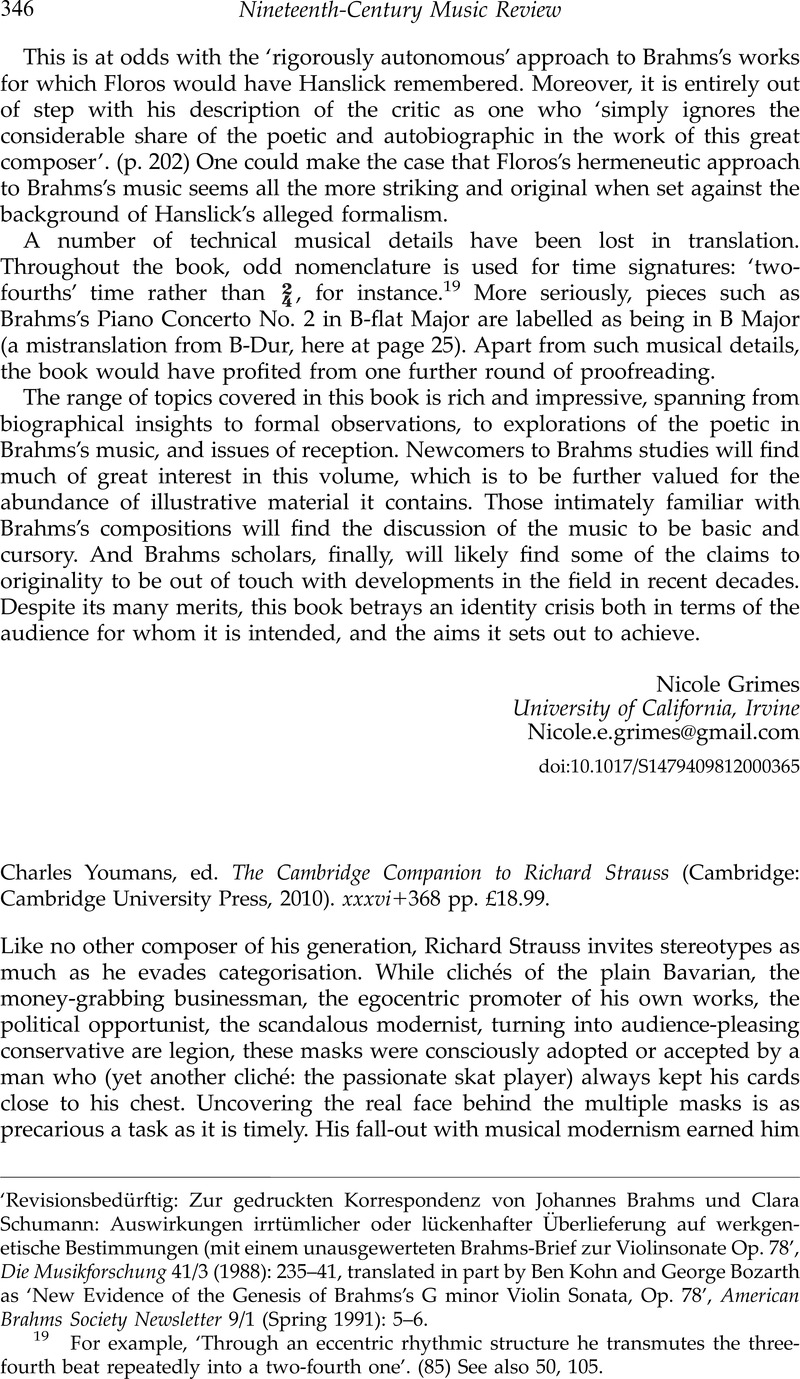No CrossRef data available.
Article contents
Charles Youmans, ed. The Cambridge Companion to Richard Strauss (Cambridge: Cambridge University Press, 2010). xxxvi+368 pp. £18.99.
Published online by Cambridge University Press: 08 January 2013
Abstract

- Type
- Book Reviews
- Information
- Copyright
- Copyright © Cambridge University Press 2012
References
1 Adorno, Theodor W., ‘Richard Strauss: Zum 60. Geburtstage: 11. Juni 1924’, in idem, Gesammelte Schriften, xviii, ed. Rolf Tiedemann (Frankfurt/Main: Suhrkamp, 1984): 254–262Google Scholar
Gillespie, Susan, ‘Richard Strauss at Sixty’, in Richard Strauss and His World, ed. Bryan Gilliam (Princeton: Princeton University Press, 1992): 406–415Google Scholar
Adorno, Theodor W., ‘Richard Strauss: Zum hundertsten Geburtstag: 11. Juni 1964,’ in idem, Gesammelte Schriften, xvi, ed. Rolf Tiedemann (Frankfurt/Main: Suhrkamp, 1978): 565–606Google Scholar
Samuel and Shierry Weber, ‘Richard Strauss: Born June 11, 1864,’ in Perspectives of New Music 4 (1965): 14–32 and 113–29Google Scholar
Adorno, Theodor W., ‘The Musical Climate for Fascism in Germany’, in idem, Gesammelte Schriften, 20/2, ed. Rolf Tiedemann (Frankfurt/Main: Suhrkamp, 1986): 430–40Google Scholar
2 An early instance of a Strauss reappraisal against the mainstream is found in Susan Sontag's essay, ‘On Camp’ (1964), published in her first collection Against Interpretation and Other Essays (New York: Farrar, Straus and Giroux, 1966): 275–92. Within Germany and Austria, public interest in Strauss was primarily non-academic or limited to societies such as the Internationale Richard-Strauss-Gesellschaft. The first research team was established, as a regular seminar for lecturers and students, by Reinhold Schlötterer at the University of Munich in 1977. See Bernd Edelmann, ‘Gegen Strauss’ Verdammnis’, Akademie Aktuell: Zeitschrift der Bayerischen Akademie der Wissenschaften (2011/2): 36–9.
3 Bryan Gilliam, ‘Friede im Innern: Strauss's Public and Private Worlds in the Mid 1930s’, Journal of the American Musicological Society 57 (2004): 579–91Google Scholar
4 Schmid, Mark-Daniel ed., The Richard Strauss Companion (Westport, CT: Praeger, 2003)Google Scholar
5 Hottmann, Katharina, ‘die andern komponieren. Ich mach' Musikgeschichte!’ Historismus und Gattungsbewusstsein bei Richard Strauss: Untersuchungen zum späteren Opernschaffen (Tutzing: Schneider, 2005)Google Scholar
6 Heisler, Wayne Jr., The Ballet Collaborations of Richard Strauss (Rochester, NY: University of Rochester Press, 2009)Google Scholar
7 The individual operas are covered on the following pages: Elektra, 120–22; Rosenkavalier, 122f.; Ariadne auf Naxos, 123–26; Die Frau ohne Schatten, 126f., Die ägyptische Helena, 128 (14 lines from the bottom of the page)–129 (line 13); Arabella, 129–31; Intermezzo, 137–40; Die schweigsame Frau, 140 (bottom)–42(top); Friedenstag, 142f.; Daphne, 144f.; Die Liebe der Danae, 145f.; Capriccio, 146–48.




